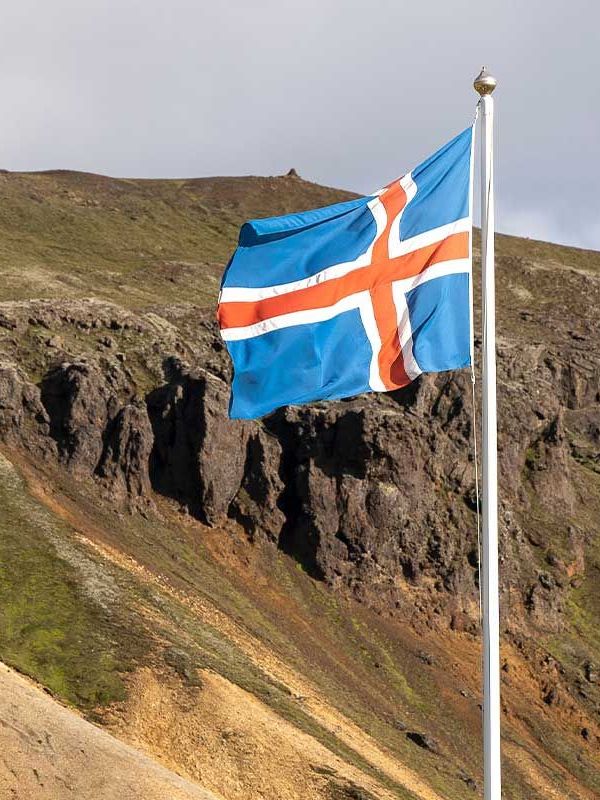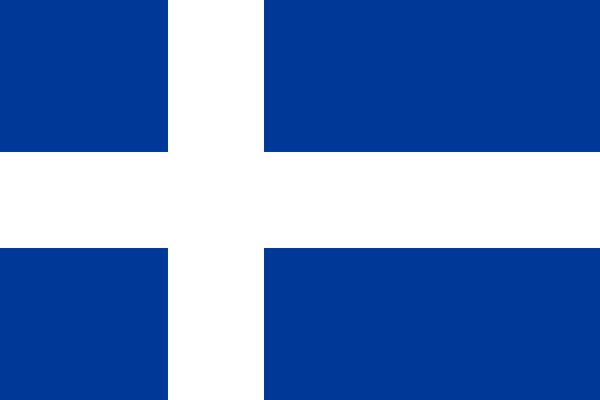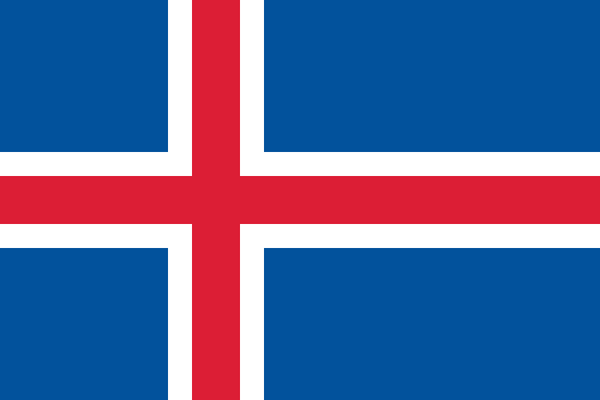
Flag of Iceland: A Symbol of Heritage and Pride
The Icelandic Flag is historic, with beautiful designs that honor the freedom of the country. In this article, we go over the history behind the flag and talk about old designs.
Let's dive on the history of the icelandic flag, with beautiful designs that honor the freedom of the country. In this article, we delve into the history behind the flag and explore old designs.
The Colors of the Icelandic Flag: What Their Meaning?
The Icelandic flag is not just a piece of cloth; it's a historic narrative woven with beautiful designs that pay homage to the nation's hard-fought freedom. Adorned with the tones of sky blue, pristine white, and vibrant red, each color intricately weaves a compelling narrative. The tranquil blue mirrors the grandeur of Iceland's mountains, the pristine white reveres its snow-clad landscapes, and the vibrant red signifies the raw power of its fiery volcanoes.
Originally, the red held a singular symbolism of Christianity, but over time, local Icelanders reclaimed it as an emblematic representation of their volcanic terrain. The white cross, a Scandinavian homage, acknowledges Iceland's deep Nordic roots. Though this flag is now an emblem commonly recognized by Icelanders, its journey through history is a profound tale of transformation.
Unearth the intriguing saga behind the Icelandic flag, tracing its roots through significant events like flag days and its esteemed position in the Prime Minister's office. Explore its presence in territorial waters, a testament to Iceland's maritime heritage. Discover connections to the Swedish flag, the establishment of the Republic of Iceland, and the era when the Danish king's rule came to an end. This symbolic tapestry, rich in history, stands not only as a representation of Iceland's heritage but also as a source of pride for its people.

Icelandic National Flag 1809 by Jorgen Jorgensen: A Blue Flag and Codfish Tale
Jorgen Jorgensen, also known as Jörundur “Hundadagakonungur”, introduced the first Icelandic national flag on July 12th, 1809. Its appearance significantly differed from the contemporary flag we recognize today. This version featured a deep blue background adorned with three white codfish positioned in the top-left corner. Even though it was a bizarre sight, it did highlight Iceland’s blue waters and one of the country’s main dishes. The flag lasted a short time since Jorgen only ruled Iceland for a few weeks after that.
Fast forward to 1870, when Sigurður Guðmundsson presented the next flag to Iceland. Popular among students advocating for Iceland's independence. This flag did not have fish on it; however, it still had a vibrant blue background. Instead of stripes or colors, this flag had a large white falcon right in the middle of it. The falcon was a symbol of Iceland rising up and, hopefully, one day gaining their freedom.

1897, the Hvítbláinn Flag: Blueprint of Iceland's Iconic Design
In 1897, the Hvítbláinn flag made its debut during a parade, marking a pivotal moment in the evolution of Iceland's national symbols. Departing from animal or fish motifs, this iteration embraced simplicity with a captivating design. It showcased a profound blue backdrop featuring a white cross, an early blueprint remarkably similar to Iceland's current flag. Consider it the initial draft in the national flag's design journey.
Crafted by Einar Benediktsson, a poet with an artistic vision, the Hvítbláinn flag held deeper symbolism. According to Benediktsson, the white represented Iceland's pristine snow, and the blue symbolized the majestic mountains that define the island's landscapes.
To connect with this historical emblem, plan a visit to the National Museum Of Iceland during your next trip. Here, the Hvítbláinn flag stands proudly on display, inviting visitors to immerse themselves in the early stages of Iceland's iconic flag design. Witness the enduring beauty of blue and white, anchored by the Scandinavian cross, a precursor to the cherished Nordic cross that adorns Iceland's flag today.

Iceland National Flag Today: A Triad of Colors Unveiled in 1906
The pivotal moment arrived in 1906 when Matthías Þórðarson unveiled the current flag of Iceland, a momentous occasion that occurred at a Reykjavík Students' Association meeting on September 27. Drawing inspiration from Einar Benediktsson's color scheme, Matthías retained the symbolic blue for mountains and white for snow. However, he introduced a significant addition—the red, now emblematic of Iceland's formidable volcanoes.
This three-color masterpiece became the unofficial civil flag in 1913, gaining official status as the nation's flag on June 19th, 1915. Its popularity surged further when Iceland achieved separation from the Danish crown. The addition of red played a crucial role in addressing concerns about the previous flag's perceived similarity to Greece. The red cross was added not only to distinguish Iceland's flag but also to underscore the significance of the Icelandic landscapes in shaping the nation's identity.
Embodied by the iconic white and blue, with the red cross as a testament to the nation's volcanic prowess, the current Icelandic flag stands tall as a symbol of heritage and pride. Its official adoption in the year the Republic of Iceland was established solidified its place in history, capturing the essence of a nation that proudly stands on its own.
Iceland has a few other flags that you may spot along your journey. The state flag is also known as the swallowtail flag. This flag is a bit different, with the Icelandic coat of arms being displayed with shield bearers on a white rectangular field.
Today, the national flag is widely known and appreciated by Icelanders everywhere. You can spot the flag throughout the streets on Iceland’s National Day too. A day when everyone in the country comes together to celebrate Iceland’s independence.
The Flag Act of Iceland
The Flag Act of Iceland, formally known as Lög um þjóðfána Íslendinga, governs the use of the national flag of Iceland. This legislation, originally enacted in 1944 after Iceland declared independence from Denmark, defines the official design and proportions of the Icelandic flag, as well as when and how it should be displayed.
The key aspects of the Flag Act include:
- Design Specifications: The flag is described as a blue field with a red cross outlined in white. The proportions and specific color codes are strictly regulated by law to ensure consistency.
- Flag Days and Rules of Display: The Act outlines official flag days, such as Icelandic National Day (June 17), and specifies the hours during which the flag should be raised and lowered. It also covers occasions like funerals or mourning, where the flag is flown at half-mast.
- Prohibited Uses: The Act regulates improper uses of the flag, prohibiting any actions that may be considered disrespectful, such as altering the design or using it for commercial purposes without permission.
Flag Days in Iceland: A Celebration of National Pride
In Iceland, flag days are not just about hoisting a flag; they're a deep-rooted celebration of national pride and cultural identity. These special days are marked by the widespread display of the Icelandic flag, known as the 'hvítbláinn' (meaning white-blue), a symbol of the nation's enduring spirit and rich heritage.
Major Flag Days in Iceland
January 1 - New Year’s Day
A joyful beginning to the year, where the flag is raised to symbolize hope and renewal.
April 1 - Birthday of the Althingi
Celebrating the founding of Iceland's parliament in 930 AD, one of the oldest in the world.
June 17 - Icelandic National Day
Commemorating the day Iceland became a republic in 1944, this is a major patriotic event with parades and festivities.
First Monday in August - Commerce Day
A day dedicated to Icelandic workers, marked with the flag to honor their contributions to the nation.
December 1 - Independence Day
Observing Iceland's independence from Denmark in 1918, a day of national pride and historical reflection.
Celebrating Flag Days
On these days, the Icelandic flag is proudly displayed across homes, public buildings, and streets. School programs, parades, and public speeches are common, with a focus on educating the younger generation about the nation’s history and values. These celebrations foster a sense of unity and national pride among Icelanders.
The Role of the Flag in Icelandic Culture
The Icelandic flag is a source of immense pride and a symbol of unity. Its presence during flag days reinforces national identity and reminds citizens of their shared history and values. It's a time for reflection on the nation’s past struggles and achievements, and an opportunity to look towards the future with optimism.
The Significance of the Icelandic Flag
Before diving into flag days, it's essential to appreciate the symbolism of the Icelandic flag. With a deep blue background representing the Atlantic Ocean, a white cross symbolizing the snow and glaciers, and a fiery red cross within the white, denoting the island's volcanic fires, the flag encapsulates Iceland's unique natural beauty.
Flag Rules in Iceland
Flag rules exist in Iceland, as well as in many other countries. This rule states that the flag should not be raised before seven o'clock in the morning. It should normally be lowered at sunset and should never be kept hoisted after midnight. Another rule is to never destroy or tamper with a flag. This could result in heavy fines or even jail time.
The Scandinavian Cross: A Symbol Deeply Rooted in Nordic Heritage
The Origin of the Scandinavian Cross
The Scandinavian Cross, a dominant feature in the flags of Nordic countries, is more than a mere design. It's a historical symbol deeply rooted in the culture and heritage of the Scandinavian region. This cross, typically extending to the edges of the flag, represents Christianity and was first used in the Danish flag, the Dannebrog, around the 12th century.
Significance of the Cross in the Icelandic Flag
In the case of Iceland, the Scandinavian Cross holds a place of pride on its national flag. Adopted in 1915, the Icelandic flag features this iconic cross in a unique color scheme: blue representing the ocean, white for the snow and ice, and red for the volcanic fire. This configuration not only aligns Iceland with its Nordic neighbors but also symbolizes the country's distinct natural elements.
The Scandinavian Cross in Nordic Flags
Each Nordic country has adapted the Scandinavian Cross in its flag, creating a visual connection between these nations. The flags of Denmark, Sweden, Norway, Finland, and Iceland, though varying in color, all share this common symbol, signifying a shared history and cultural connection.
The Cross as a Unifying Symbol
The use of the Scandinavian Cross in flags reflects a deep sense of unity and shared identity among the Nordic countries. It's a symbol that transcends borders, representing common values, a shared history of Viking ancestry, and a mutual respect for peace, democracy, and cooperation.
The Cross in Modern Icelandic Culture
In Iceland, the flag with the Scandinavian Cross is a source of immense national pride. It's displayed in various forms across the country and is an integral part of national celebrations and cultural events. It serves as a constant reminder of Iceland's rich history and its connection to the broader Scandinavian region.
Where to Buy the Icelandic Flag: A Guide for Visitors and Enthusiasts
Purchasing in Iceland
- Specialty Stores in Reykjavik: Reykjavik, the capital city, offers the most variety. Specialty stores here sell authentic Icelandic flags, often accompanied by a certificate of authenticity.
- Souvenir Shops: Throughout Iceland, particularly in tourist-heavy areas, souvenir shops stock the Icelandic flag in various sizes. These are ideal for visitors wanting a keepsake.
- Online Icelandic Retailers: For those who prefer shopping online, Icelandic retailers offer the flag on their websites. This option is great for ensuring authenticity and supporting local businesses.
Buying Abroad
- Online Marketplaces: International online marketplaces like Amazon and eBay often have Icelandic flags available. However, it's important to check the reviews and vendor information for authenticity.
- Specialty Nordic Stores: In countries with significant Nordic communities, specialty stores might stock the Icelandic flag. These are often authentic and of high quality.
Things to Consider When Purchasing
- Size and Material: Flags come in various sizes and materials, from small hand flags to large ceremonial ones. Consider the purpose of your purchase when choosing.
- Authenticity: Ensure you're buying an authentic Icelandic flag, especially if it's for a special occasion or as a meaningful souvenir.
- Local Regulations: In Iceland, there are specific regulations about how and when the flag can be displayed. It’s respectful to be aware of these when purchasing and using the flag.
Whether you're in Iceland or abroad, there are several options for purchasing an authentic Icelandic flag. Remember to consider the size, material, and authenticity to ensure you're getting a flag that meets your needs and respects Icelandic traditions.
